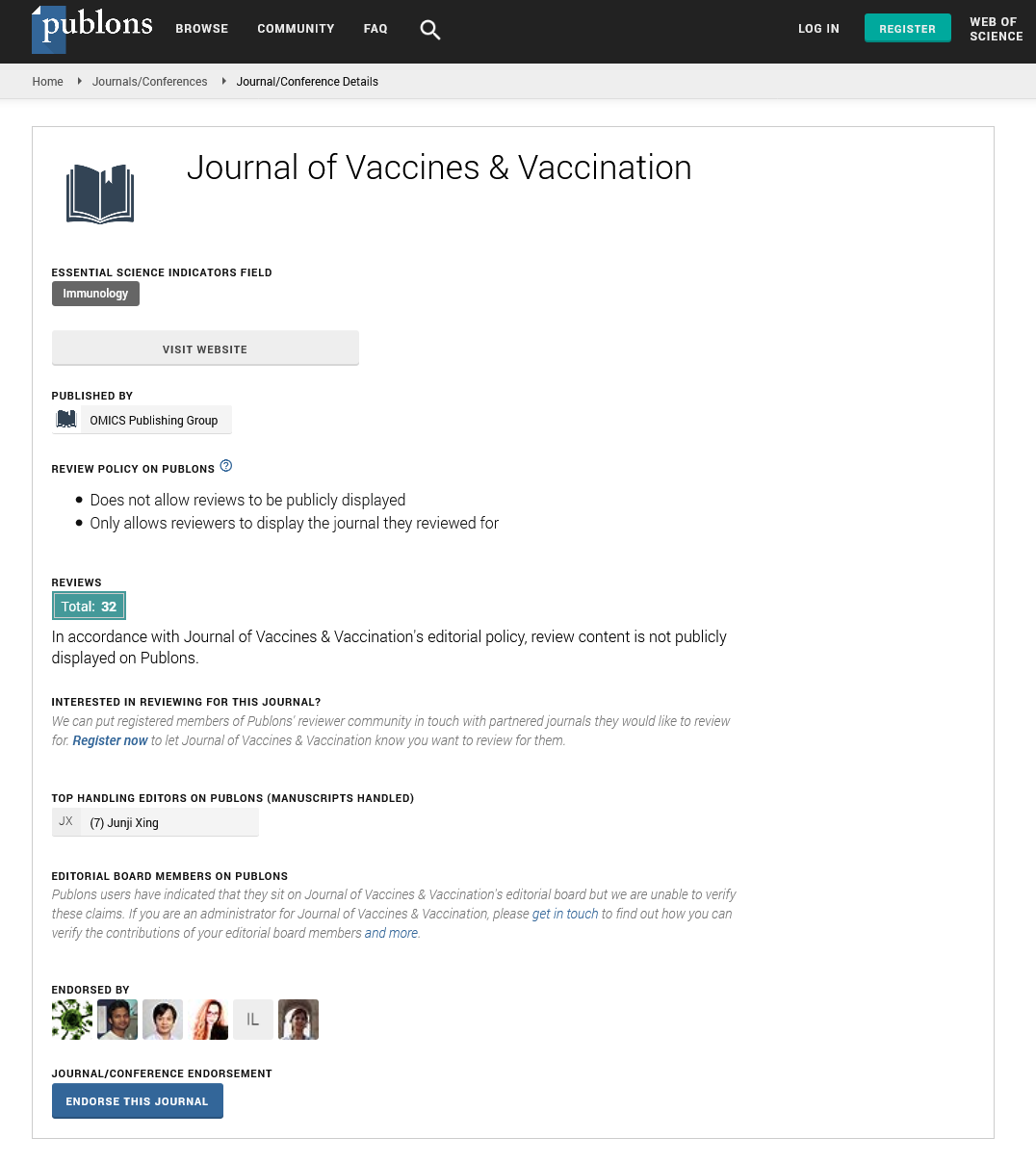PMC/PubMed Indexed Articles
Indexed In
- Academic Journals Database
- Open J Gate
- Genamics JournalSeek
- JournalTOCs
- China National Knowledge Infrastructure (CNKI)
- Scimago
- Ulrich's Periodicals Directory
- RefSeek
- Hamdard University
- EBSCO A-Z
- OCLC- WorldCat
- Publons
- MIAR
- University Grants Commission
- Geneva Foundation for Medical Education and Research
- Euro Pub
- Google Scholar
Useful Links
Share This Page
Open Access Journals
- Agri and Aquaculture
- Biochemistry
- Bioinformatics & Systems Biology
- Business & Management
- Chemistry
- Clinical Sciences
- Engineering
- Food & Nutrition
- General Science
- Genetics & Molecular Biology
- Immunology & Microbiology
- Medical Sciences
- Neuroscience & Psychology
- Nursing & Health Care
- Pharmaceutical Sciences
Perspective - (2024) Volume 0, Issue 0
Emerging Communication Technologies in Vaccine Education: Digital Frontiers of Health Engagement
Hui Shansi*Received: 27-Sep-2024, Manuscript No. JVV-24-27685; Editor assigned: 30-Sep-2024, Pre QC No. JVV-24-27685 (PQ); Reviewed: 15-Oct-2024, QC No. JVV-24-27685; Revised: 22-Oct-2024, Manuscript No. JVV-24-27685 (R); Published: 29-Oct-2024, DOI: 10.35248/2157-7560.24.S29.002
Description
The way medical information is produced, disseminated and comprehended is changing dramatically due to previously unheard-of technical advancements that are revolutionising vaccination communication. The entire ecosystem of health communication and public participation is being redefined by digital technologies, which are no longer supplemental tools but essential platforms. In vaccine education, artificial intelligence proves to be a particularly potent catalyst due to its exceptional capacity to contextualise and personalise medical information. With the use of machine learning algorithms, it is now possible to analyse intricate demographic and psychological data and develop communication tactics that specifically address people's information demands, cultural contexts and personal worries. Because human health decision-making is so complicated, these technologies create nuanced, adaptive communication strategies that go beyond generic messaging. Immersion learning experiences are being produced by virtual and augmented reality technology, which turn abstract medical ideas into concrete, emotionally compelling stories. Imagine a community learning about the historical significance of vaccination through interactive digital storytelling, or a youngster investigating the microscopic path a vaccine takes through the human body. These tools go beyond the confines of conventional education to make difficult scientific material interesting, approachable and intensely personal. Social media platforms have developed into complex public health ecosystems from basic routes of communication. These days, sophisticated analytic algorithms can monitor vaccine sentiment, spot new issues and create realtime, focused communication plans that allay particular community fears. Health information can be continuously improved and modified in the dynamic, responsive digital ecosystem. Blockchain technology has fascinating answers to the problem of the reliability of vaccine information. These technologies can aid in the fight against false information, offer trustworthy immunisation records and foster confidence in digital health ecosystems by establishing transparent, verifiable information chains. A significant change in the management and exchange of medical data is represented by the possibility of developing safe, decentralised health information networks. Individual interaction with immunisation information is being revolutionised by mobile health applications. Real-time immunisation tracking, side effect monitoring and personalised instructional content that adjusts to each user's unique health profile are now possible with personalised apps. People are empowered by these technologies, which increase the accessibility, interactivity and personal significance of health information. The communication of complex medical information is being revolutionised by data visualisation technology. Dry scientific data may be made into engaging, readily understood tales with the help of interactive graphics, animated explanations and dynamic statistical representations. By connecting between scientific complexity and public comprehension, these technologies improve the transparency and appeal of vaccine information. Chatbots and virtual health aides driven by artificial intelligence are redefining the way that people communicate about their health. These technologies can offer round-the-clock assistance, respond to specific enquiries, deal with particular issues, and deliver culturally appropriate information based on the needs of each individual. A noteworthy development in health education is the fusion of sophisticated technology and compassionate communication. Strategies for vaccine communication are becoming more proactive and individualised thanks to predictive analytics technologies. Largescale dataset analysis enables these technologies to spot possible hesitation trends, forecast community reactions and create focused intervention plans before false information spreads. This signifies a significant change from reactive to proactive health communication. Even with these technological advancements, ethical questions are becoming important. The risk of algorithmic bias, privacy violations and technical exclusion necessitates ongoing critical assessment. Maintaining inclusive, courteous and open digital health communication necessitates a careful balancing act between technology innovation and fundamental human rights.
The capacity to use these tools to build real human connections, rather than the technology itself, is what will determine the future of vaccine communication. These technologies need to be platforms that increase human empathy, understanding and well-being rather than acting as impediments. Unprecedented potential to safeguard and strengthen international communities are presented by the meeting point of technical progress and human ingenuity.
Citation: Shansi H (2024). Emerging Communication Technologies in Vaccine Education: Digital Frontiers of Health Engagement. J Vaccines Vaccin. S29:002.
Copyright: © 2024 Shansi H. This is an open access article distributed under the terms of the Creative Commons Attribution License, which permits unrestricted use, distribution and reproduction in any medium, provided the original author and source are credited.

